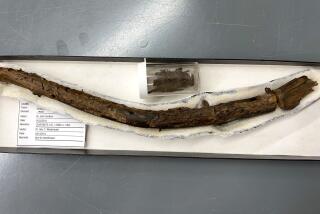Use Prevention, Patience to Fight Garden Freeze
The prolonged blast of arctic air that invaded California last month left its chilling effects in gardens throughout the Southland.
Brittle, dead leaves hung on many fruit and ornamental trees, tender shrubs withered in protest of the icy air. Many ground covers and bedding plants died.
Protecting plants from cold weather is something cold-climate gardeners are accustomed to doing but Southern California gardeners rarely have to consider. But the wise gardener should resist the understandable temptation to correct the damage immediately. It’s too soon to try to prune or replant.
“As ugly as the garden may look, it’s better for the plants if home gardeners just do nothing for a month or so,” said Mary Brosius of Burkard Nurseries in Pasadena. “Although the sub-freezing temperatures killed leaves, it’s too soon to determine what parts of the plants were also killed.”
Brosius advises waiting until spring, when plants produce new growth. “Then the gardener will clearly see just where the plants were damaged. If pruning were done now, the gardener would probably remove more of the plant than necessary.”
Jerry Foster, nursery manager at Roger’s Gardens in Corona del Mar, also counsels patience.
“It’s too early to try to correct any of the damage caused by the December freeze,” he said. Pruning a plant sends it a signal to produce new growth. Many parts of the Los Angeles area may still experience frost, and the tender new growth would be damaged severely by more freezing weather.
Although the actual damage may have seemed as erratic as a tornado, there was a pattern.
“We experienced losses in plants grown in containers that were placed on the ground, yet the same plants in baskets hanging four feet in the air were fine,” Foster said. “It all depended on where the pockets of cold air accumulated.”
Some areas near the coast, where temperatures are warmer, escaped with little damage. Inland, especially in canyons, the damage was more widespread. Foster even saw frost-damaged geraniums, an unusual occurence since they are so hardy.
Many of the tropical and subtropical plants that normally flourish in our mild climate were, predictably, affected severely. Bouganvillea, hibiscus, impatiens, ficus and citrus were hit hard. But mature plants and trees should survive.
“Everything I would expect to die, did,” said David Lofgren, horticulturist with the Los Angeles County Arboretum in Arcadia.
“Much of the damage depended on the individual microclimate of the location. Since rivers of cold air flow downhill, tropical plants in a low point in the garden will be more damaged than those on the side or top of the hill or sheltered against a structure.”
Some areas of the arboretum were 5 degrees colder than others, Lofgren said. Navel orange trees in those areas were hurt, but those planted on rises retained leaves and fruit.
Lofgren also cautioned against a garden cleanup in January.
“Be a do-nothing gardener right now. The dead foliage that remains protects from further frost damage by acting as a heat-insulating cover for the lower leaves that are still green, he said.”
Some tropicals such as datura will resprout from their roots, so they should not be yanked out of the ground. When hibiscus bud out in the spring, a light shearing will restore the plant’s attractiveness.
Although many bouganvillea look as if they can’t possibly survive, most will send out new growth in the spring. Frost damage will probably occur in just the upper portions of the plant, which can be removed.
Although citrus crops were ruined, most of the trees in the Southland should survive, including the avocados. “Unless the trees are 5 years or younger, they will probably be fine,” Lofgren said.
Amid the damage, there are some species that actually benefit from a prolonged chill.
“Spring flowering of roses should be spectacular, particularly the Old Garden roses that bloom just once a year,” said Tom Carruth, a hybridizer for Weeks Roses in Upland.
“Roses and other members of the rose family, including peach, nectarine and plum trees, actually benefit from the dormancy that cold weather promotes. We can anticipate heavy flowering of the fruit trees too.”
However, he pointed out that fruit production can be affected if temperatures descend after they flower. And the possibility remains of additional cold weather before spring.
It’s not too late to think about protecting your valued plants if another freeze should occur. Horticulture experts recommend the following:
* Know your garden and its cold spots. Avoid placing tender plants in the coolest areas. They are best protected growing under eaves or sheltering trees.
* Anything frost-sensitive growing in a container should be moved indoors or to a protected location.
* Cover small shrubs or plants with newspaper. This prevents heat loss and offers protection from the cold air of the night sky.
* Larger plants or trees can be covered. Be sure to use sheets, blankets or shade cloth. Avoid plastic, since the thin material won’t prevent heat loss, Some cold storms are accompanied by high winds, and protective covers can be blown off.
A source of heat--a floodlight shining down on the tree or plant, a 100-watt light bulb at the base of the tree--will provide some protection, as will metal garbage cans upended over plants.
* Wait for February to replant bedding or other plants in the ground. Many wholesale growers suffered damage to their plants, and are currently growing their inventories in greenhouses. These plants will need time for hardening off before they can be planted in outdoor garden settings.






